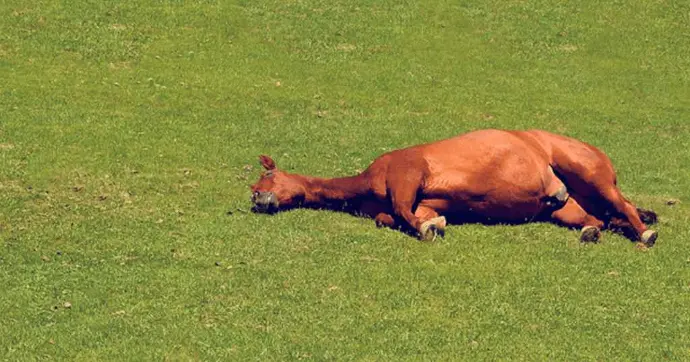If you were asked how to optimise your horse’s performance, it is likely you will think about meeting his nutritional needs, following a strict conditioning regimen, or ensuring that he is in ‘good’ health… Would bedding even come into your mind?
‘Good’ sleep is extremely important for our horses and bedding type, quality, cleanliness and depth can influence sleep characteristics, and therefore, affects performance and welfare. So, let’s look at what we know…
What is sleep?
Sleep occurs in all mammals and consists of four stages: Non-rapid eye movement sleep (NREM), including slow wave sleep (SWS), makes up the first three phases and is usually followed by a fourth phase – the rapid eye movement (REM) sleep phase. REM sleep is characterised by atonia – a state in which most muscles of the body completely relax.
Sleep is extremely important because of its restorative properties. It reduces our heart rate and blood pressure, for instance. A chronic lack of REM sleep can impair cognitive performance, and trigger or worsen cardio-vascular and other metabolic diseases to the extent that it can significantly shorten our life span and, in the worst-case scenario, lead to death. Like in humans, a lack of REM sleep can also be detrimental to horse health and well-being.
How do horses sleep?
Healthy horses sleep between three to five hours daily. Whilst horses can remain standing during the NREM phases, they must lie down to complete the REM phase, either on their chest and abdomen with their muzzle resting on the floor (sternal recumbency) or on the left or right side of their body with their head and neck resting on the ground (lateral recumbency).

Whilst no standing REM phases have been recorded in relaxed horses, a small number of horses, although the exception, may not lie down when entering the REM sleep phase. This can usually be attributed to stress (e.g., new environment) or discomfort (pain, improper ground surface or stall size). However, when horses enter the REM sleep phase while standing, their head and neck drop due to atonia, consequently, their muzzle may hit the floor. This is usually the point when most horses wake up again, but some may partially collapse, and therefore, could seriously injure themselves when entering REM sleep whilst standing.
What role does bedding play?
Bedding type, quality, cleanliness, and depth can positively impact sleep quality and, consequently, well-being. Stable or resting area size, light exposure, environmental stressors, rank of individual horses within a group (if group-housed), and pre-existing diseases, pain, or discomfort can also impact sleep behaviour in horses.
Increasing bedding depth can positively affect horse welfare and performance. When kept on deeper bedding (e.g., 6 inches), irrespective of bedding type, horses spent more time lying down, particularly in lateral recumbency, which is one of the two sleeping positions required to enter and complete REM sleep phases.
Research has shown that horses who are relaxed and physically comfortable spent more time in lateral recumbency. Therefore, a calm environment and bedding cleanliness are of utmost importance since horses spent significantly less time resting on wet bedding, which may reduce the amount of REM sleep. It seems that horses preferred straw bedding over shavings or pellets, and the use of wood shavings significantly reduced the time horses spent in lateral recumbency in one study.
The downsides of rubber mats
The combined use of rubber mats and shavings is very popular in some parts of the world, particularly in countries where horses are kept indoors for a significant amount of time throughout the day and night.
In a proportion of horse barns, however, rubber mats are barely covered with bedding, which not only makes it uncomfortable for horses to lie down, but also negatively impacts air quality (ammonia concentrations) and, therefore, respiratory health and welfare.
Using rubber mats alone or with only a thin layer of shavings has shown to significantly reduce, both, lateral and sternal recumbency sessions and time. Rubber mats, irrespective of their thickness, did not compensate for insufficient bedding depth. Therefore, rubber mats should be covered with an adequate amount of bedding (between 4-6 inches were used in the studies).
To summarise
Horses unable to experience REM sleep can develop serious health problems, which negatively affects their welfare. Bedding type and depth can significantly impact horse sleep and, therefore, performance.
While not all bedding types provide the same benefits, you certainly can’t go wrong adding a little more bedding depth to your horse’s resting areas. There is certainly some truth to the saying “What is better than a good night’s sleep?”
SOURCE: HORSES&PEOPLE




